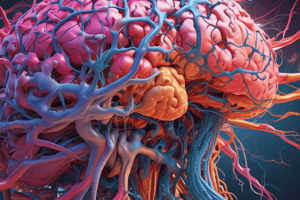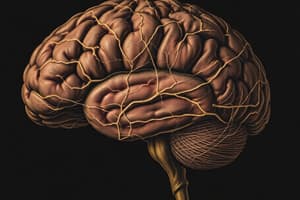Podcast
Questions and Answers
What are the two primary divisions of the nervous system?
What are the two primary divisions of the nervous system?
- Central nervous system and peripheral nervous system (correct)
- Hindbrain and forebrain
- Medulla and cerebellum
- Brain and spinal cord
What does the central nervous system comprise?
What does the central nervous system comprise?
The brain and spinal cord
What vital functions does the medulla control?
What vital functions does the medulla control?
- Reflexes controlling breathing
- Heartbeat, circulation, and respiration (correct)
- Sensory processing
- Movement and balance
The pons is responsible for controlling the muscles on the left side of the body.
The pons is responsible for controlling the muscles on the left side of the body.
Which structure is known for controlling movement, balance, and coordination?
Which structure is known for controlling movement, balance, and coordination?
What happens if there is damage to the pons?
What happens if there is damage to the pons?
What is the role of the tegmentum?
What is the role of the tegmentum?
What does the thalamus do?
What does the thalamus do?
Damage to the hypothalamus can disrupt motivated behaviors such as feeding and temperature regulation.
Damage to the hypothalamus can disrupt motivated behaviors such as feeding and temperature regulation.
What is the function of the pituitary gland?
What is the function of the pituitary gland?
The __________ is involved in incentive motivation and reward-seeking behaviors.
The __________ is involved in incentive motivation and reward-seeking behaviors.
Flashcards are hidden until you start studying
Study Notes
The Nervous System: Communication and Control Network
- The nervous system acts as the body's primary communication and control network using electrical signals.
- Signals travel from sense organs to the brain and back through complex neuron networks at lightning speed (milliseconds).
Central Nervous System (CNS): The Brain and Spinal Cord
- The CNS comprises the brain and spinal cord.
- It acts as the central coordinating system for the body.
- Both organs are enclosed and guarded by the skull (brain) and vertebral column (spinal cord) respectively.
The Brain: Structure and Function
- The brain is divided into three main sections: the hindbrain, midbrain, and forebrain.
Hindbrain: Vital Control Center
- The hindbrain consists of the medulla, pons, and cerebellum.
- Medulla (or medulla oblongata) controls crucial functions like heartbeat, circulation, and respiration.
- It serves as a relay station for sensory and motor impulses.
- Damage to the medulla leads to immediate death.
- Pons controls muscles on the right side of the body, while the right hemisphere controls the left.
- It acts as a relay station and is involved in reflexes for breathing.
- Damage to the pons can cause sleep disturbances, sensory problems, arousal dysfunction, and coma.
- Cerebellum is a large structure responsible for movement, balance, coordination, and complex information processing.
- It plays a role in executive functions and emotional processing.
- Abnormal cerebellum development is linked to autism spectrum disorder, affecting language, cognition, and social skills.
Midbrain: Sensory Processing and Movement
- The midbrain comprises the tectum and tegmentum.
- Tectum: contains the superior colliculus (vision) and the inferior colliculus (hearing).
- These structures are crucial for sensory processing.
- Tegmentum: includes the substantia nigra, a dopamine producer that facilitates movement and reward-seeking behaviors.
- Degeneration of the substantia nigra causes Parkinson's disease, characterized by movement initiation difficulties.
- The ventral tegmental area (VTA) in the tegmentum is important for motivation related to appetitive stimuli like food and sex.
Forebrain: Higher-Level Functions
- The forebrain includes two cerebral hemispheres, the thalamus, hypothalamus, pituitary gland, limbic system, and basal ganglia.
- Thalamus: processes most sensory input and relays it to the cerebral cortex.
- Damage to the thalamus can result in coma, and disrupted thalamus-cerebral cortex circuits contribute to seizures.
- Hypothalamus: transmits messages to the pituitary gland, influencing hormone release.
- It plays a role in motivated behaviors like eating, drinking, temperature regulation, sexual behavior, aggression, and activity levels.
- Damage to any part of the hypothalamus can disrupt these behaviors.
- Pituitary gland: a hormone-producing gland attached to the hypothalamus.
- It releases hormones into the bloodstream in response to signals from the hypothalamus, affecting various organs.
- Basal ganglia: a group of interconnected structures involved in motor control, learning, and reward processing.
Peripheral Nervous System (PNS): Nerve Network Outside the CNS
- The PNS is the nervous system outside the CNS.
- It includes all the nerves that branch out from the brain and spinal cord to connect to the rest of the body.
- The PNS is responsible for transmitting sensory information from the body to the CNS and motor commands from the CNS to the muscles and glands.
- It is divided into the somatic nervous system and the autonomic nervous system.
Somatic Nervous System
- The somatic nervous system controls voluntary movements.
- It connects the CNS to skeletal muscles.
- It receives sensory information from receptors in the skin, muscles and joints.
- The somatic system allows for conscious control over body movements.
Autonomic Nervous System
- The autonomic nervous system controls involuntary bodily functions like heartbeat, digestion, and breathing.
- It is divided into the sympathetic and parasympathetic nervous systems.
Sympathetic Nervous System
- The sympathetic nervous system is responsible for the "fight-or-flight" response.
- It prepares the body for action by increasing heart rate, blood pressure, and breathing rate, and dilating pupils.
Parasympathetic Nervous System
- The parasympathetic nervous system is responsible for the "rest-and-digest" response.
- It slows down heart rate and breathing rate, constricts pupils, and stimulates digestion.
Brain-Behavior Connection
- The brain is responsible for all our thoughts, feelings, and behaviors.
- The complex interaction between different brain areas leads to a vast array of behaviors.
- Damage to specific brain areas can lead to specific behavioral impairments.
Relationship Between Mind and Body
- The brain and body are interconnected.
- The nervous system plays a crucial role in mediating this relationship by controlling both physiological processes and mental states.
- Stress, emotions, and thoughts can all influence physiological responses through the nervous system.
Studying That Suits You
Use AI to generate personalized quizzes and flashcards to suit your learning preferences.




